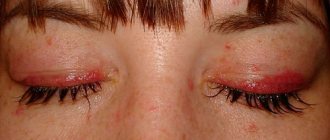Pepper spray is the most popular means of self-defense today. It can be purchased without special permission, but should be used strictly when necessary. Despite the apparent harmlessness of the aerosol, a chemical burn from pepper spray poses a danger to the cornea of the eyes, mucous membranes of the nose and throat.
What is pepper spray and how does it work?
Pepper spray is an aerosol that contains a chemical compound that irritates the eyes, causing tearing, burning, pain and temporary blindness when sprayed towards the face. The tear agent is used in policing, riot control and self-defense, including defense against wild animals. The effect of the spray on the enemy allows the person in danger to escape, and the police officer to effectively restrain the criminal.
The active ingredient in pepper spray is capsaicin, a chemical derived from the fruit of the cayenne pepper plant, including chili peppers. Capsaicin is extracted from capsicums using an organic solvent such as ethanol. The solvent is then evaporated, and the remaining wax-like resin is oleoresin capsicum (OC), an extract of hot pepper.
Pepper sprays can contain from 0.18 to 3% active ingredient. However, a high percentage of the main ingredient is not always an indicator of potency, since it is not known whether the quality of pepper oil used was high or low. There are six types of capsaicinoids of varying quality. Manufacturers do not specify one variety or another on their products. The most common in everyday use are cans containing from 1.3 to 2% of the active substance.
Eye burn from pepper what to do
Hot spices are loved by millions of people in many countries.
Even the unpleasant sensations that hot peppers can cause after careless handling and consumption of them do not reduce the army of “hot” fans.
Experienced “pepper eaters” know how painful the burns of chili peppers and other hot pepper pods are, so they take precautions when working with them. But beginners often get burns to their hands, eyes, and mouth.
Hot peppers sometimes cause fire inside
Why does hot pepper leave a burn?
What gives pepper its spiciness is a special substance – capsaicin, which is found in the seeds, peel, and veins of the fruit. The substance is oily and causes burning, redness of the skin, swelling, and itching.
The main culprit of heat is capsaicin.
It is dangerous for the health of allergy sufferers, as it causes an acute allergic reaction even with slight contact with pepper. It takes a long time to be eliminated from the body, which is why pepper burns for several days.
During this time, you can only weaken the power of its action. It should be remembered that not only the fresh product causes burns, but also dried fruits, since capsaicin retains its burning properties in any form.
This property is used in the manufacture of pepper patches.
Important! The hottest ones are the white partitions in the middle of the pods. They contain 60% capsaicin. The seeds, peel and pulp contain the remaining 40% of the alkaloid.
What types of pepper cause a burning sensation?
Hot pepper is used in cooking to add piquancy and special aroma to meat, fish, and vegetable dishes. But if consumed carelessly, it causes burns to the gastric mucosa and even leads to internal bleeding, which is the reason for emergency hospitalization. The painful effect of a skin burn can last up to 3 days.
Cayenne pepper, which is loved by many spicy lovers
Numerous varieties have hotness, in particular chili and hot red pepper. It is measured in Scovilles, named after the American chemist Wilbor Scoville, who created the hotness scale for pepper fruits back in 1921 after numerous experiments with the study of capsaicin in the pods.
Different varieties of pepper have different levels of heat. Asian ones instantly burn, while Mexican ones slowly reveal their taste. South American and Asian peppers are considered the hottest; pods with a milder taste are grown in Europe.
According to the ECU scale, the hottest peppers include:
- Poblano . 1,000–2,000 ECU. The pepper is named after the Mexican region where it grows. The seasoning made from Poblanos is called ancho chile. Fresh fruits are stuffed and served as a separate dish.
- Serrano . 10,000–25,000 ECU. The pods taste a little spicier than Jalapeños, but at first they do not burn your mouth too much. However, you should know that its pungency appears gradually, and after a while it will bake in the mouth with all its force.
- Jalapeño . 2,500–10,000 ECU. This pepper has earned fame as almost the hottest, but its heat on the Scoville scale is quite modest. Spicy lovers can easily eat it raw.
- Habanero . 3500 – 570 000 ECU. Pepper with a frighteningly hot taste. Connoisseurs love it for its slight citrus tint in taste.
- Thai . 75000-150 000 ECU. Thai is the name given to different varieties of peppers growing in Thailand. They are all sharp. Their burning sensation passes in a quick wave through the esophagus and stomach, then subsides.
- Cayenne . 30,000-50,000 ECU. Many people's favorite hot pepper. Goes great with meat and cheese. It is used to make salsa.
- Pimento . 100–500 ECU. The variety is called cherry for its similarity in shape and color to cherries. Paprika is made from it, so its taste is not very spicy, but at the same time juicy and sweet.
- Red Savina . 350,000–577,000 ECU. A variety of Habanero, obtained by chance as a result of cross-pollination. It causes numbness in the lips, an increase in blood pressure and body temperature, so only true fanatics of spicy foods consume it, savoring it little by little as an exquisite delicacy.
- Carolina Reaper. 1,400,000–2,200,000 ECU. Pepper with a very interesting taste. At first, a sweet-fruity taste is felt, gradually giving way to a very strong pungency.
Source: https://adminlen.ru/ozhog-glaza-percem-chto-delat/
Symptoms and consequences of a pepper spray burn
Pepper spray causes a sharp inflammatory reaction in the mucous membrane of the eyes and respiratory tract. The reaction to spraying is expressed in severe burning of the eyes, shortness of breath, runny nose and cough. The duration of the effect depends on the strength of the spray, but on average the full effect lasts from 20 to 90 minutes.
Pepper spray can be much more dangerous than is commonly believed, including chemical burns to the eyes and temporary blindness that lasts 15 to 30 minutes and a burning sensation of the skin for 45 to 60 minutes. Upper body spasms occur, causing the person to double over, and uncontrollable coughing occurs. The victim has difficulty breathing and speaking for 3 to 15 minutes.
The general sensations after spraying are most correctly compared to getting a burn. When the chemical comes into contact with the skin, the sensation is sometimes described by victims as "bubbling and boiling." Subsequent inhalations through the nose or mouth result in the ingestion of the chemical, causing a feeling of suffocation.
Despite the fact that the drug is considered non-life threatening, in rare cases it can be fatal. For those who have asthma, take other medications, or have conditions that limit their airways, there is a risk of death.
In a study conducted at the Aberdeen Proving Ground (USA) in 1993, scientists concluded that pepper spray can cause “mutagenic, carcinogenic effects, sensitization, cardiovascular and pulmonary toxicity, neurotoxicity, and possible loss of life.”
Treating Eye Burns from Pepper Spray
What to do if your eyes are burned? Depending on the extent of the damage, chemical damage is treated with therapeutic and surgical methods. In a hospital setting, treatment includes the following:
- elimination of pain manifestations. For this purpose, intramuscular cycloplegic drugs are prescribed. But at first, you can get by with oral analgesics;
- Every day the eyes are washed with Albucid and lidocaine drops;
- the inflammatory process negatively affects the organs of vision, in particular the cornea of the eye. Steroids are used to reduce inflammation. Treatment with these drugs is carried out in the first days after injury and lasts no more than 10 days;
- after pepper liquid gets on the mucous membrane, tear production decreases and the need for hydration with drops or gels appears. The doctor also prescribes ascorbic acid, which has a beneficial effect on collagen fibers and accelerates the process of corneal restoration. Take acid 2-4 times a day;
- Infection can be prevented using topical antibiotics;
- Intraocular pressure is reduced using blockers that affect the intraocular fluid.
Albucid is used for treatment
If the therapy does not give the desired result, the patient is prescribed surgery. It is carried out using one of the following methods:
- removal of deformed parts of the conjunctiva and symblepharon;
- transplantation of conjunctival or mucosal flaps;
- correction of a deformed eyelid;
- keratoplasty;
- keratoprosthesis.
If for some reason you are unable to see a doctor after receiving an injury, Visin eye drops or those containing diclofenac will help alleviate the condition.
Traditional methods of treating chemical eye burns with pepper spray
You can combine drug treatment with folk remedies. This will increase the chances of a speedy recovery. Herbal infusions help a lot. Eyebright promotes eye regeneration, strengthens the optic nerve, reduces lacrimation and relieves inflammation. To prepare the infusion, you need to pour 1 teaspoon of the herb into 300 ml of boiling water and leave for half an hour. After the decoction has cooled, soak a cotton pad in it and apply it to the injured eye. A drink can be prepared from the same raw materials. Pour a teaspoon of plants with a glass of boiling water and leave for 20 minutes. You need to drink the infusion three times daily for a week.
Cornflower improves cell regeneration, protects the retina, cornea and lens from degenerative processes. Pour a teaspoon of dried flowers into a glass of boiling water and leave covered for 15 minutes. Strain and drink warm, half a glass 2 times a day.
An infusion for a compress is made using the same recipe. Cotton pads soaked in it are applied to the eyes for 10-15 minutes. Tea tea lotions will help improve the recovery process.
Emergency care for a pepper spray burn
After studying the five most popular treatments for chemical burns from pepper spray (baking soda, 2% lidocaine gel, baby shampoo, milk or water), the researchers concluded that there was no significant difference between them in terms of pain relief and overall well-being. Time turned out to be the best doctor.
Emergency measures
First of all, the victim is advised to remain as calm as possible and not to panic. What to do next depends on which part of the body is affected and to what extent.
Eye injury
Capsaicin does not dissolve in water, and even large volumes of water will not wash it away. But soapy water or, preferably, water with the addition of baby shampoo will help alleviate the condition somewhat. In case of eye burns, rinsing with pepper spray should be carried out for 10-15 minutes.
If you have milk on hand (preferably high-fat), then wash your face generously with milk, then rinse everything off with a solution made from soda and water (3 teaspoons of soda per 1 liter of water). The eyes should then be gently dabbed with a clean paper towel, after which victims are encouraged to blink frequently and vigorously to produce tears, which will help flush the irritant out of the eyes more effectively. Experts advise, if possible, to be in the fresh air to quickly dissipate the burning fumes.
Some "triple action" pepper sprays also contain tear gas, which can be neutralized with sodium metabisulfite (Campden tablets, used in home brewing), although this is also insoluble in water and must be washed off using a similar procedure as pepper spray.
Skin damage
The skin, like the eyes, is urgently washed with plenty of water and baby shampoo. Then the affected area is generously moistened with a soda solution (50 g per 1.5 liters of cool water). After the acute pain subsides, apply a rich cream or natural olive oil.
What to do if pepper spray gets into your eyes or skin
Pepper sprays are especially popular among a certain part of the population of our country. This is not strange, because you can become a participant in a conflict at any time, without even knowing it. Naturally, it happens that you can become a victim of spraying, and you are the injured person and not the attacker. In this situation, you just need to understand what to do if pepper spray gets into your eyes and skin, so as not to harm yourself even more.
Everyone knows that the main complaints after spraying a gas canister in the face, the main complaints are burning of the skin, pain in the eyes and watery eyes. The most striking effect of the spray lasts for the first 3-5 minutes after the lesion, after which this pain may fade into the background. The main problem remains pain and watery eyes, which take much longer to resolve if certain measures are not taken.
Timely provision of medical assistance will help you quickly get back on your feet and begin treatment. This will be much easier to do if you have a friend with you or you can quickly find someone who agrees to help you.
First aid steps after spraying
A certain procedure should be followed so as not to aggravate the situation, but to relieve pain and avoid serious injuries. It is very important to follow everything described below in a certain sequence. This instruction will help you come to your senses faster and stop the pain soon.
After contact with an irritating substance, your condition will be critical. Naturally, all the advice may simply fly out of your head. We recommend that you gather your thoughts and under no circumstances try to rub your eyes with your hands. Such actions will only lead to an expansion of the affected area and even greater pain.
First stage
The first step is to call a person for help (if possible) and ask them to remove the bulk of the substance from your face. Remember, you cannot wipe the substance, you should just blot it so that the cloth or napkin absorbs the solution. The fabric should be applied and removed, and so on in a circle, until the bulk of the substance is removed.
Second phase
Trying to open your eyes is also a bad idea. The body will not allow you to open your eyes completely, but if you are lucky, you risk introducing even more irritant to the retina. This will only increase the pain, but will not bring any benefit.
If possible, try blinking rapidly. This will trigger the extra tear gland to flush the substance out of your eyes.
Third stage
Next, you should find a nearby store yourself or ask an assistant. In it you need to purchase milk with maximum fat content, a bottle of water and baking soda. After which you should rinse your face and eyes in a certain sequence.
- Washing with milk. Milk contains a high mass of fats, which will be seized by lachrimators without being fully dissolved. Milk works well against pepper spray.
- After this, you need to mix baking soda with still water. 15 grams per bottle of water will be enough. This solution can help you get rid of the CN spray.
- Also, you can buy baby soap and wash your face and eyes with it. The burning sensation may only get worse, but this is normal.
Go to the clinic
After the previous stages, you will come to a more or less stable state and will be able to move. Try to find out where the hospital is nearby and head there. Doctors will provide you with professional assistance and improve your general condition.
Contact a pharmacy
If you do not have the opportunity to get to the hospital, then you should go to the nearest pharmacy, since there are enough of them in every city. There they can offer you many medications that will relieve pain and restore your general condition. The most commonly used drugs are:
- Diclofenac. These are eye drops that relieve inflammation well. Please note that you should apply eye drops according to the instructions and do not exceed the dosage. The effect may not appear immediately, so you should wait a little.
- Drops containing lidocaine. These drops have good analgesic properties, because they are made on the basis of an anesthetic. They should be used no more than 1-2 times, as excessive use can cause rapid loss of vision.
- Drops like Visine. They have no effect other than cosmetic. They do an excellent job of eliminating eye redness and reducing inflammation, but are useless as an anesthetic.
Self-defense means in our online store The use of such self-defense means can cause certain painful sensations, so they should be used only as a last resort. In our store you can find the most reliable and popular means of self-defense permitted by current legislation. The pages of the site offer a wide range of products, so you are sure to choose a device that will help you in the event of a conflict.
To receive professional advice from our specialists or place an order, you can call us at the phone number listed on the website. Call us, we will always be happy to help you protect yourself and your loved ones.
Further drug therapy
After emergency assistance is provided to the victim, it is necessary to monitor the condition of the eyes and skin for at least 2-3 days. At this time, to relieve inflammation, it is recommended to regularly lubricate the affected areas of the epidermis with anti-burn agents (Panthenol, Pantoderm) or anesthetic ointments (Lidocaine gel 2%). The medicine is applied to the burn area in a thin layer according to the instructions. Drug therapy is aimed at relieving redness, burning and soreness, and accelerating tissue regeneration.
Restoration of the mucous membrane of the eyes will be more effective and less painful if Albucid is instilled into them 3-4 times a day according to the instructions (prevents bacterial infection) and Lidocaine 2% (has an analgesic effect). Visine or artificial tears will help get rid of irritation and redness in the whites of the eyes.
If irritation and swelling have not completely disappeared after 24 hours, it would be useful to take an antiallergic drug such as Claritin or Suprastin.
Pepper got into the eyes. What to do for first aid for an adult and a child
The eyes are an irreplaceable organ that helps us navigate the world around us .
Therefore, it is very important to keep them healthy.
Let's consider what actions should be taken if pepper gets into your eyes.
In this case, ingestion of hot red pepper is accompanied by severe pain and burning sensation .
The symptoms in the case of ground black pepper are less pronounced.
How to avoid getting burned?
Apart from hand-to-hand combat, pepper spray is the primary and only means of defense available to civilians against intruders. But it often happens that people using the canister are themselves exposed to pepper spray. To avoid burn damage to the eyes and skin, experts advise beginners to first practice using a safe can of compressed air. You should learn how to quickly take out and use the product correctly: hold it at arm's length, pointing the sprayer towards the enemy.
It is strictly not recommended to spray the aerosol:
- against the wind – in variable wind conditions it is better not to use the spray can;
- indoors - in this case, everyone who was nearby will suffer to varying degrees;
- close to your own face - spraying is allowed at arm's length.
Avoid touching your own face after using pepper spray. Particles of a chemical substance deposited on the fingers can get onto the mucous membranes of the eyes or delicate skin of the face.
What to do?
Rinsing the affected areas with water is contraindicated, especially if CR pepper spray was used for exposure.
In the first minutes it is important not to cough.
Under no circumstances should you rub your eyes or face after exposure to gas, and do not panic. You should try to avoid coughing at least a couple of times. Each cough provokes a new urge. You should try to blink frequently. If it is difficult to open your eyes, you can help by supporting the eyelids with dry handkerchiefs, but not with your hands, which also came under the gas spray. Blot the tears with a handkerchief or towel and preferably not in the eye area (let them flow down to the chin). Do not use the victim's clothing to wipe away tears. It is not advisable to reuse the napkin so as not to return washed out toxic substances into the eyes. The action of CS will help neutralize the alcohol, but it can also seriously burn the skin.
Then you should wash your hands thoroughly with soap. Then it is important to wash your face and rinse your eyes with milk several times. It neutralizes the effect of poison in the eye area. Milk should not be washed off with water; it is better to blot it with a dry towel or soda solution. To prepare, you will need to stir 20 g in 1 liter of water. After the manipulations, it is recommended to go to the clinic. After examination, the ophthalmologist will be able to prescribe medications. Most often used:
- "Albucid" for washing;
- Diclofenac drops will help eliminate the inflammatory process;
- Ophthalmic drops "Lidocaine" anesthetize the eyes, but only once;
- Visine will help relieve redness.
Asthmatics and allergy sufferers need immediate medical attention to rule out pulmonary edema, suffocation, or death as a result of exposure to gas aerosols. For a child’s body, gas ingestion can also have serious consequences, most likely even requiring hospitalization. Therefore, you should keep pepper spray away from children.










